The Influence of the South-to-North Water-Diversion Project on Terrestrial Water-Storage Changes in Hebei Province
Abstract
:1. Introduction
2. Materials and Methods
2.1. Study Area
2.2. Datasets
2.2.1. GRACE Datasets
2.2.2. Meteorological Data
2.2.3. Auxiliary Data
2.3. Methods for Estimating TWSA
2.3.1. Water-Balance (WB) Method
2.3.2. Climate-Driven TWSA Reconstruction
2.3.3. Mann–Kendall (MK) Trend Test
2.3.4. Evaluation Indexes
2.3.5. Research Framework
3. Results
3.1. Evaluation of Different Meteorological Products
3.2. Reconstruction of TWSA in Hebei Province
3.3. Temporal Characteristics of TWSA in Hebei Province
3.4. Spatial Distribution Characteristics of TWSA in Hebei Province
4. Discussion
4.1. The Influence of the SNWD Project on Plain and Mountain Regions
4.2. The Influence of the SNWD Project on the Spatial Distribution Characteristics of TWSA in Hebei Province
5. Conclusions
Author Contributions
Funding
Institutional Review Board Statement
Informed Consent Statement
Data Availability Statement
Acknowledgments
Conflicts of Interest
References
- Li, B.; Rodell, M.; Zaitchik, B.F.; Reichle, R.H.; Koster, R.D.; van Dam, T.M. Assimilation of GRACE terrestrial water storage into a land surface model: Evaluation and potential value for drought monitoring in western and central Europe. J. Hydrol. 2012, 446–447, 103–115. [Google Scholar] [CrossRef]
- Zeng, N.; Yoon, J.; Mariotti, A.; Swenson, S. Variability of Basin-Scale Terrestrial Water Storage from a PER Water Budget Method: The Amazon and the Mississippi. J. Clim. 2008, 21, 248–265. [Google Scholar] [CrossRef]
- Xie, J.; Xu, Y.; Wang, Y.; Gu, H.; Wang, F.; Pan, S. Influences of climatic variability and human activities on terrestrial water storage variations across the Yellow River basin in the recent decade. J. Hydrol. 2019, 579, 124218. [Google Scholar] [CrossRef]
- Long, D.; Yang, W.; Sun, Z.; Cui, Y.; Zhang, C.; Cui, Y. GRACE satellite-based estimation of groundwater storage changes and water balance analysis for the Haihe River Basin. Shui Li Xue Bao 2023, 54, 255–267. (In Chinese) [Google Scholar]
- Zhang, M.; Teng, Y.; Jiang, Y.; Yin, W.; Wang, X.; Zhang, D.; Liao, J. Evaluation of Terrestrial Water Storage Changes over China Based on GRACE Solutions and Water Balance Method. Sustainability 2022, 14, 11658. [Google Scholar] [CrossRef]
- Nie, N.; Zhang, W.; Zhang, Z.; Guo, H.; Ishwaran, N.; Tsakiris, G. Reconstructed Terrestrial Water Storage Change from 1948 to 2012 over the Amazon Basin with the Latest GRACE and GLDAS Products. Water Resour. Res. 2016, 30, 279–294. [Google Scholar] [CrossRef]
- Wenjie, Y.; Litang, H.; Chan, H.S.; Menglin, Z.; Yanguo, T. Reconstructing Terrestrial Water Storage Variations from 1980 to 2015 in the Beishan Area of China. Geofluids 2019, 2019, 3874742. [Google Scholar]
- Tapley, B.D.; Bettadpur, S.; Ries, J.C.; Thompson, P.F.; Watkins, M.M. GRACE Measurements of Mass Variability in the Earth System. Science 2004, 305, 503–505. [Google Scholar] [CrossRef]
- Wahr, J.; Swenson, S.; Zlotnicki, V.; Velicogna, I. Time-variable gravity from GRACE: First results. Geophys. Res. Lett. 2004, 31, 293–317. [Google Scholar] [CrossRef]
- Chen, J.L.; Wilson, C.R.; Tapley, B.D.; Yang, Z.L.; Niu, G.Y. 2005 drought event in the Amazon River basin as measured by GRACE and estimated by climate models. J. Geophys. Res. 2009, 114. [Google Scholar] [CrossRef]
- Wei, F.; Lemoine, J.M.; Min, Z.; Tou-Tse, H. Terrestrial water storage changes in the Amazon basin measured by GRACE during 2002–2010. Chin. J. Geophys. 2012, 55, 814–821. [Google Scholar]
- Long, D.; Chen, X.; Scanlon, B.R.; Wada, Y.; Hong, Y.; Singh, V.P.; Chen, Y.; Wang, C.; Han, Z.; Yang, W. Have GRACE satellites overestimated groundwater depletion in the Northwest India Aquifer? Sci. Rep. 2016, 6, 24398. [Google Scholar] [CrossRef]
- Singh, L.; Saravanan, S. Satellite-derived GRACE groundwater storage variation in complex aquifer system in India. Sustain. Water Resour. Manag. 2020, 6, 43. [Google Scholar] [CrossRef]
- Huang, Z.; Pan, Y.; Gong, H.; Yeh, P.J.F.; Li, X.; Zhou, D.; Zhao, W. Subregional-scale groundwater depletion detected by GRACE for both shallow and deep aquifers in North China Plain. Geophys. Res. Lett. 2015, 42, 1791–1799. [Google Scholar] [CrossRef]
- Shu, Q.Y.; Pan, Y.; Gong, H.L.; Huang, Z.Y.; Zheng, L.Q. Spatiotemporal analysis of GRACE—Based groundwater storage variation in North China Plian. Remote Sens. Land Resour. 2018, 30, 132–137. (In Chinese) [Google Scholar]
- Feng, W.; Zhong, M.; Lemoine, J.; Biancale, R.; Hsu, H.; Xia, J. Evaluation of groundwater depletion in North China using the Gravity Recovery and Climate Experiment (GRACE) data and ground-based measurements. Water Resour. Res. 2013, 49, 2110–2118. [Google Scholar] [CrossRef]
- Mo, S.; Zhong, Y.; Forootan, E.; Shi, X.; Feng, W.; Yin, X.; Wu, J. Hydrological droughts of 2017–2018 explained by the Bayesian reconstruction of GRACE(-FO) fields. Water Resour. Res. 2022, 58, e2022WR031997. [Google Scholar] [CrossRef]
- Yang, X.; Tian, S.; You, W.; Jiang, Z. Reconstruction of continuous GRACE/GRACE-FO terrestrial water storage anomalies based on time series decomposition. J. Hydrol. 2021, 603, 127018. [Google Scholar] [CrossRef]
- Rateb, A.; Sun, A.; Scanlon, B.R.; Save, H.; Hasan, E. Reconstruction of GRACE Mass Change Time Series Using a Bayesian Framework. Earth Space Sci. 2022, 9, e2021EA002162. [Google Scholar] [CrossRef]
- He, L.; Jiao, M.; Wang, Y.; Li, T. Combined model-based prediction and hazard assessment of land subsidence in Tianjin. Water Resour. Hydropower Eng. 2022, 53, 178–189. (In Chinese) [Google Scholar]
- Li, J.; Tang, H.; Rao, W.L.; Zhang, L.; Sun, W.K. Influence of South-to-North Water Transfer Project on the changes of terrestrial water storage in North China Plain. J. Univ. Chin. Acad. Sci. 2020, 37, 775–783. (In Chinese) [Google Scholar]
- Cao, Y.Q.; Wang, F. Spatial and temporal variation of vegetation and its response to meteorological drought in Hebei Province. S. N. Water Transf. Water Sci. Technol. 2021, 19, 208–719. (In Chinese) [Google Scholar]
- Save, H.; Bettadpur, S.; Tapley, B.D. High-resolution CSR GRACE RL05 mascons. J. Geophys. Res. 2016, 121, 7547–7569. [Google Scholar] [CrossRef]
- Wiese, D.N.; Landerer, F.W.; Watkins, M.M. Quantifying and reducing leakage errors in the JPL RL05M GRACE mascon solution. Water Resour. Res. 2016, 52, 7490–7502. [Google Scholar] [CrossRef]
- Zheng, L.; Pan, Y.; Gong, H.; Huang, Z.; Zhang, C. Comparing Groundwater Storage Changes in Two Main Grain Producing Areas in China: Implications for Sustainable Agricultural Water Resources Management. Remote Sens. 2020, 12, 2151. [Google Scholar] [CrossRef]
- Gong, H.; Pan, Y.; Zheng, L.; Li, X.; Zhu, L.; Zhang, C.; Huang, Z.; Li, Z.; Wang, H.; Zhou, C. Long-term groundwater storage changes and land subsidence development in the North China Plain (1971–2015). Hydrogeol. J. 2018, 26, 1417–1427. [Google Scholar] [CrossRef]
- Xu, F.L.; Guo, B.; Ye, B.; Ye, Q.; Wang, W.J. Applicability of GPM Satellite precipitation product in the Huang-Huai-Hai Plain. S. N. Water Transf. Water Sci. Technol. 2019, 17, 79–86. (In Chinese) [Google Scholar]
- Martens, B.; Miralles, D.G.; Lievens, H.; van der Schalie, R.; de Jeu, R.A.M.; Fernández-Prieto, D.; Beck, H.E.; Dorigo, W.A.; Verhoest, N.E.C. GLEAM v3: Satellite-based land evaporation and root-zone soil moisture. Geosci. Model Dev. 2017, 10, 1903–1925. [Google Scholar] [CrossRef]
- Miralles, D.G.; Holmes TR, H.; De Jeu RA, M.; Gash, J.H.; Meesters, A.G.C.A.; Dolman, A.J. Global land-surface evaporation estimated from satellite-based observations. Hydrol. Earth Syst. Sci. 2011, 15, 453–469. [Google Scholar] [CrossRef]
- Ek, M.B.; Mitchell, K.E.; Lin, Y.; Rogers, E.; Grunmann, P.; Koren, V.; Gayno, G.; Tarpley, J.D. Implementation of Noah land surface model advances in the National Centers for Environmental Prediction operational mesoscale Eta model. J. Geophys. Res. Atmos. 2003, 108. [Google Scholar] [CrossRef]
- Wu, J.; Gao, X. A gridded daily observation dataset over China region and comparison with the other datasets. Chin. J. Geophys. 2013, 56, 1102–1111. (In Chinese) [Google Scholar]
- Nie, S.; Zheng, W.; Yin, W.; Zhong, Y.; Shen, Y.; Li, K. Improved the Characterization of Flood Monitoring Based on Reconstructed Daily GRACE Solutions over the Haihe River Basin. Remote Sens. 2023, 15, 1564. [Google Scholar] [CrossRef]
- Zhong, Y.; Bai, H.; Feng, W.; Lu, J.; Humphrey, V. Separating the precipitation-and non-precipitation-driven water storage trends in China. Water Resour. Res. 2023, 59, e2022WR033261. [Google Scholar] [CrossRef]
- Mo, S.; Zhong, Y.; Forootan, E.; Mehrnegar, N.; Yin, X.; Wu, J.; Feng, W.; Shi, X. Bayesian convolutional neural networks for predicting the terrestrial water storage anomalies during GRACE and GRACE-FO gap. J. Hydrol. 2021, 604, 127244. [Google Scholar] [CrossRef]
- Hu, B.; Wang, L. Terrestrial water storage change and its attribution: A review and perspective. Water Resour. Hydropower Eng. 2021, 52, 13–25. (In Chinese) [Google Scholar]
- Sun, W.; Jin, Y.; Yu, J.; Wang, G.; Xue, B.; Zhao, Y.; Fu, Y.; Shrestha, S. Integrating satellite observations and human water use data to estimate changes in key components of terrestrial water storage in a semi-arid region of North China. Sci. Total Environ. 2020, 698, 134171. [Google Scholar] [CrossRef]
- Long, D.; Shen, Y.; Sun, A.; Hong, Y.; Longuevergne, L.; Yang, Y.; Li, B.; Chen, L. Drought and flood monitoring for a large karst plateau in Southwest China using extended GRACE data. Remote Sens. Environ. 2014, 155, 145–160. [Google Scholar] [CrossRef]
- Zhang, C.; Duan, Q.; Yeh, P.J.F.; Pan, Y.; Gong, H.; Gong, W.; Di, Z.; Lei, X.; Liao, W.; Huang, Z. The effectiveness of the South-to-North Water Diversion Middle Route Project on water delivery and groundwater recovery in North China Plain. Water Resour. Res. 2020, 56, e2019WR026759. [Google Scholar] [CrossRef]
- Strassberg, G.; Scanlon, B.R.; Chambers, D. Evaluation of groundwater storage monitoring with the GRACE satellite: Case study of the High Plains aquifer, central United States. Water Resour. Res. 2009, 45. [Google Scholar] [CrossRef]
- Rodell, M.; Chen, J.; Kato, H.; Famiglietti, J.S.; Wilson, N.C.R. Estimating groundwater storage changes in the Mississippi River basin (USA) using GRACE. Hydrogeol. J. 2007, 15, 159–166. [Google Scholar] [CrossRef]
- Niazkar, M.; Hajizadeh Mishi, F.; Türkkan, G. Assessment of artificial intelligence models for estimating lengths of gradually varied flow profiles. Complexity 2021, 2021, 5547889. [Google Scholar] [CrossRef]
- Shen, Y.; Zheng, W.; Zhu, H.; Yin, W.; Xu, A.; Pan, F.; Wang, Q.; Zhao, Y. Inverted algorithm of groundwater storage anomalies by combining the GNSS, GRACE/GRACE-FO, and GLDAS: A case study in the North China Plain. Remote Sens. 2022, 14, 5683. [Google Scholar] [CrossRef]

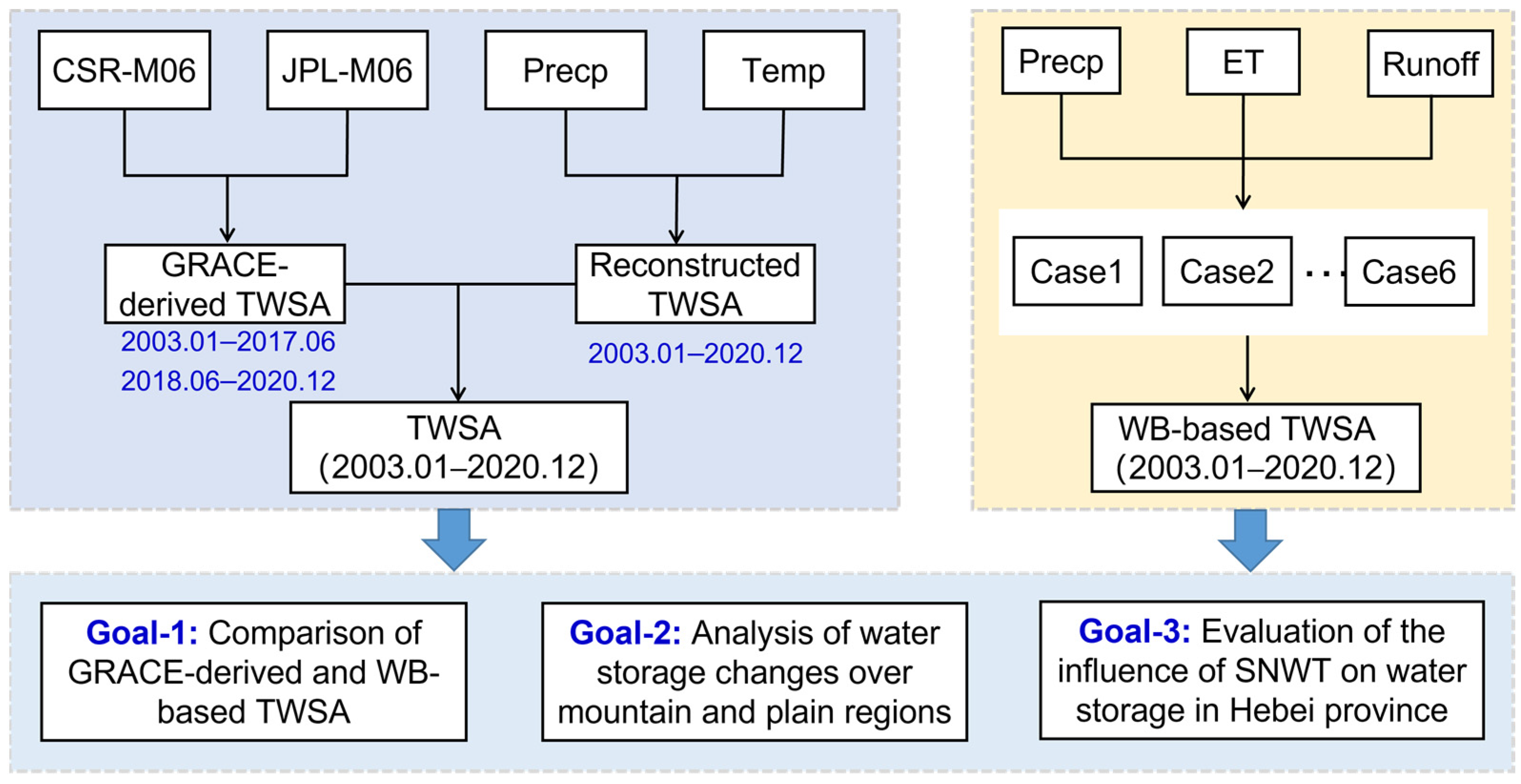

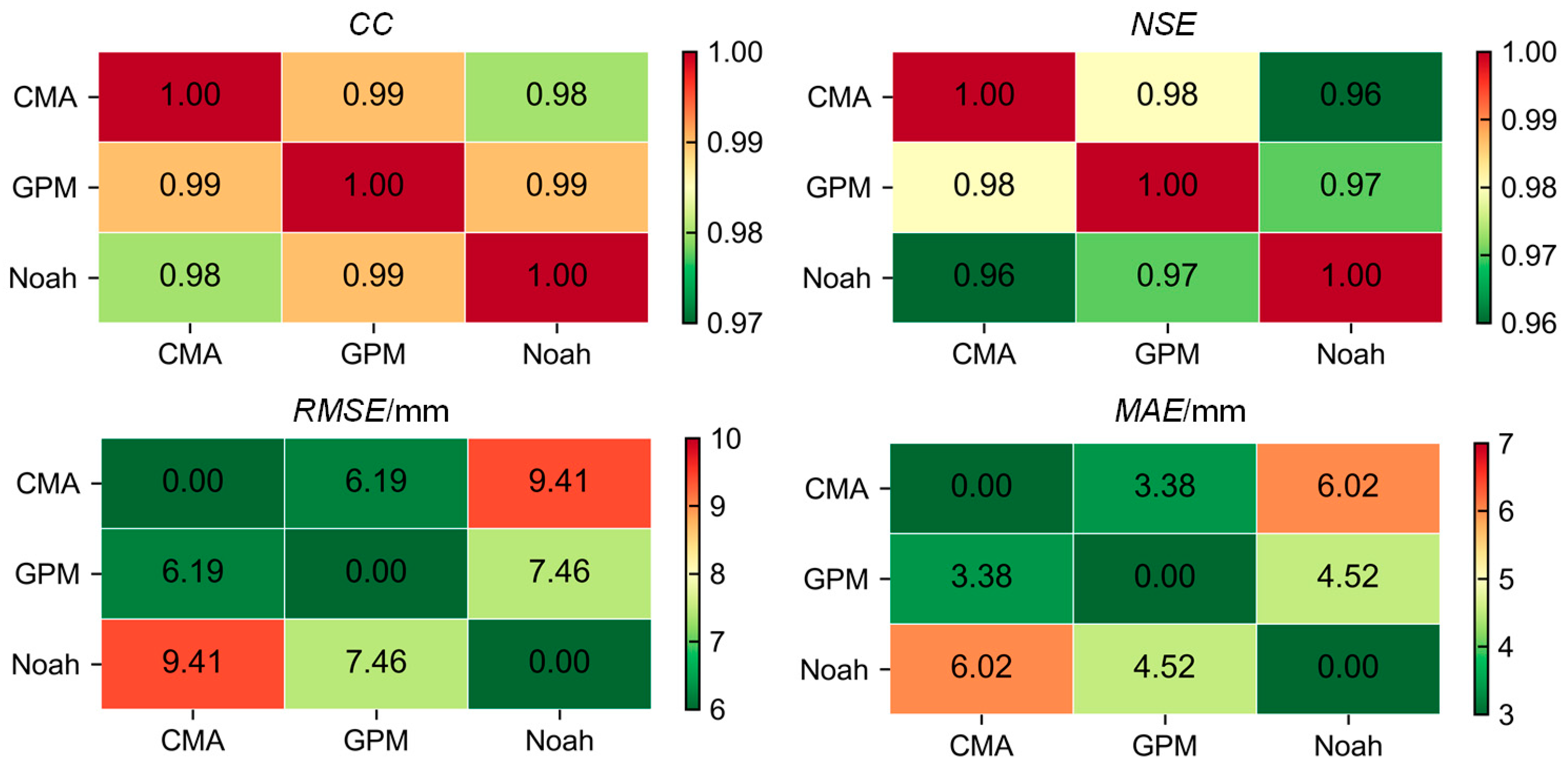
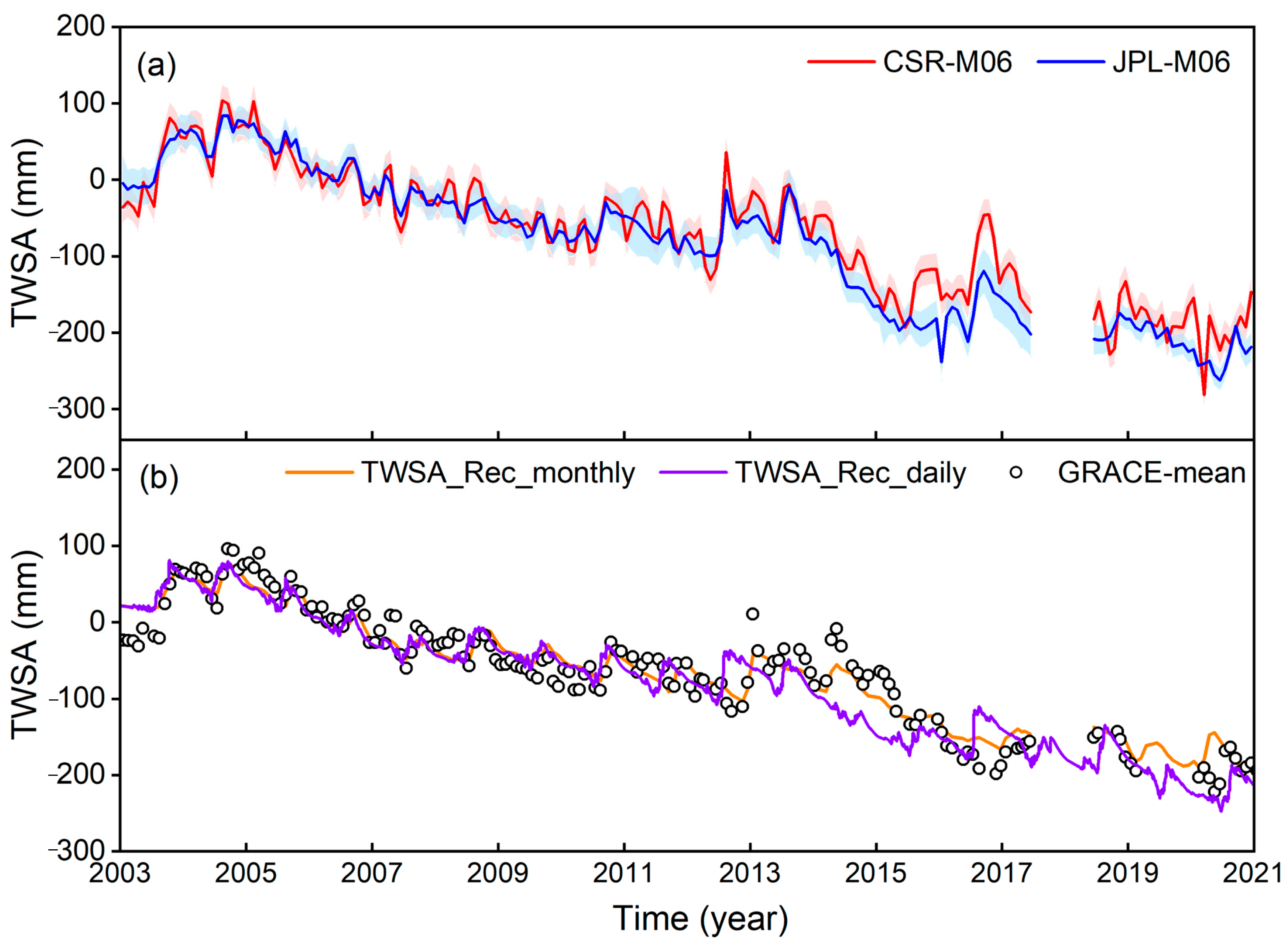
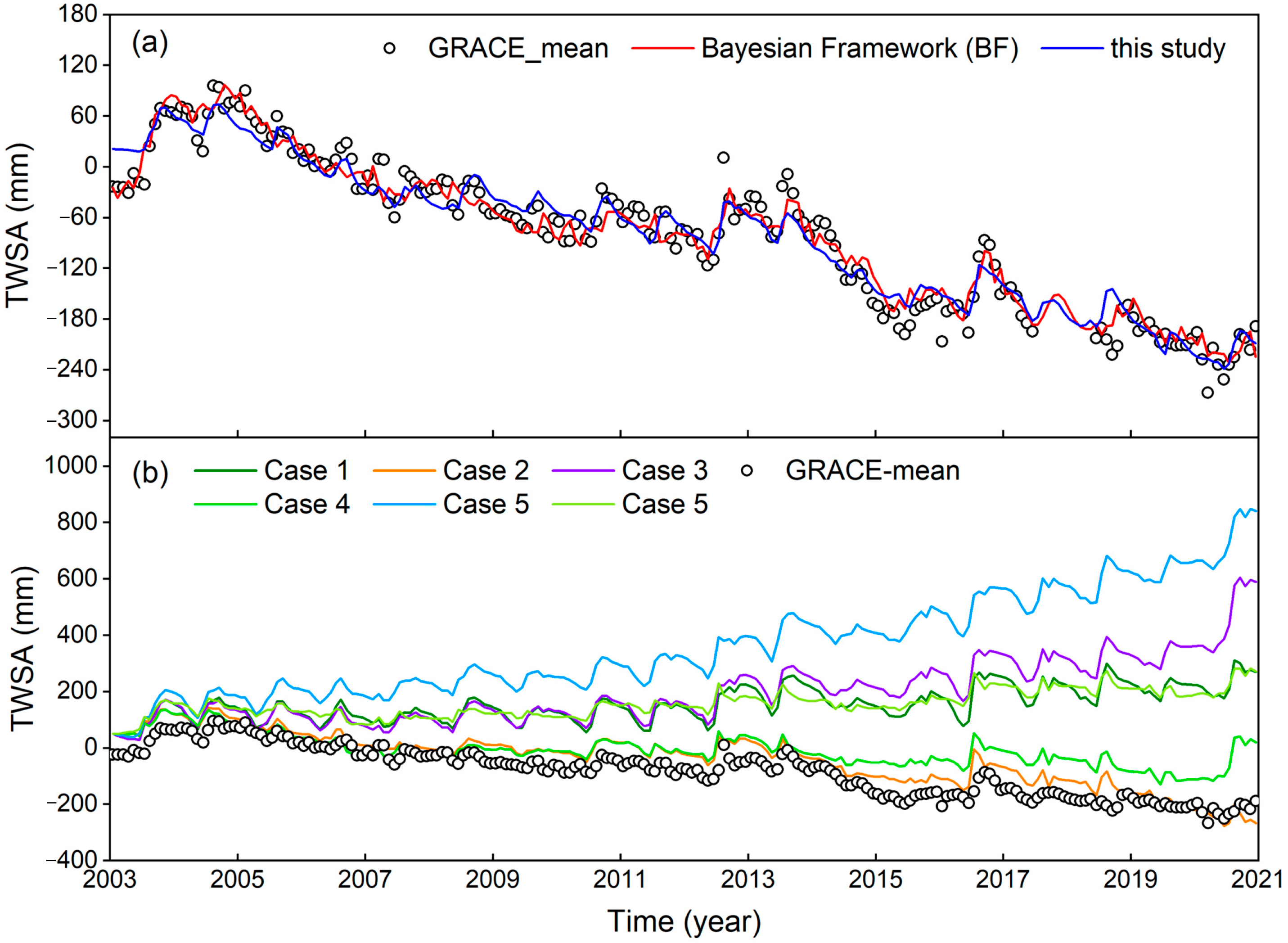
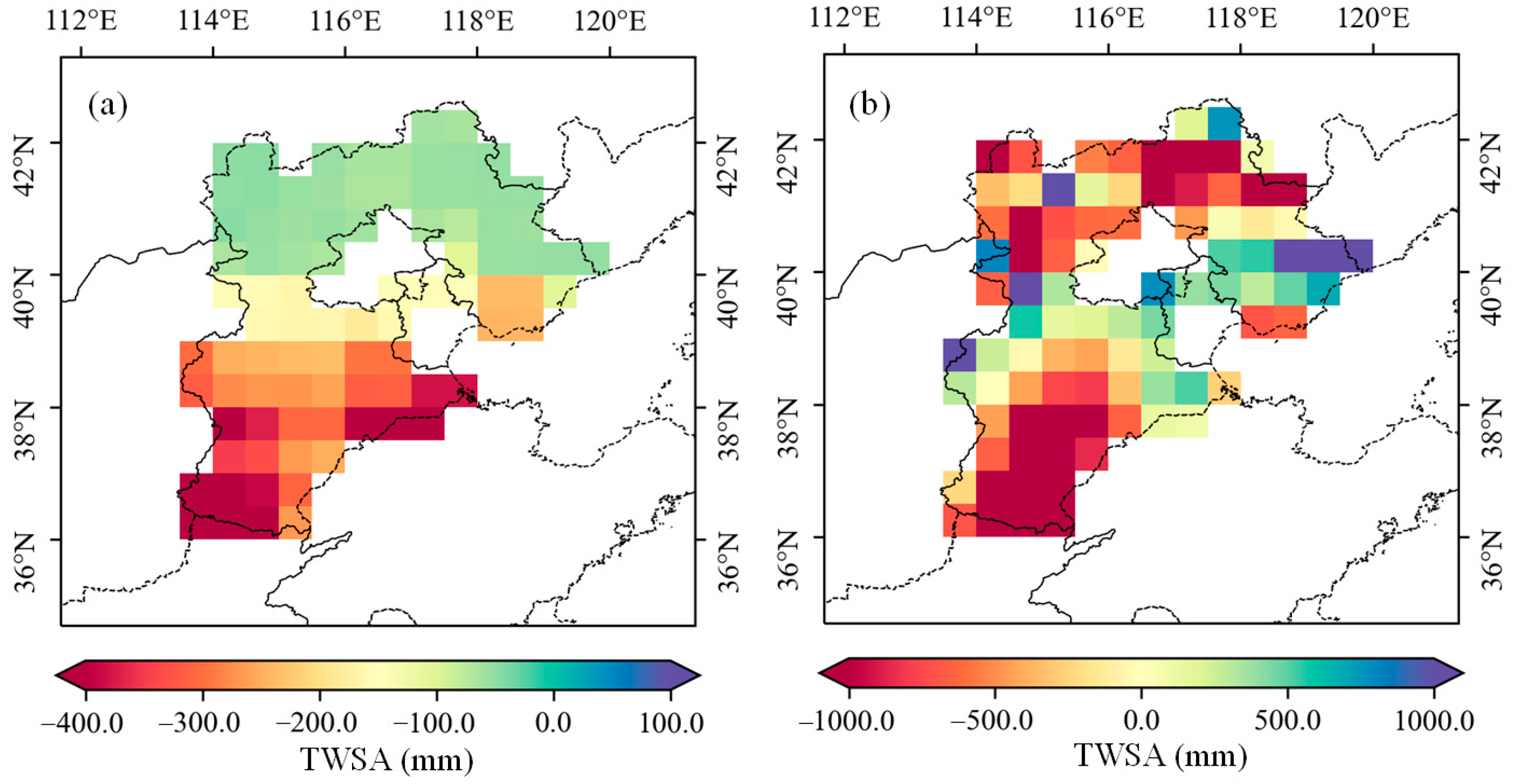
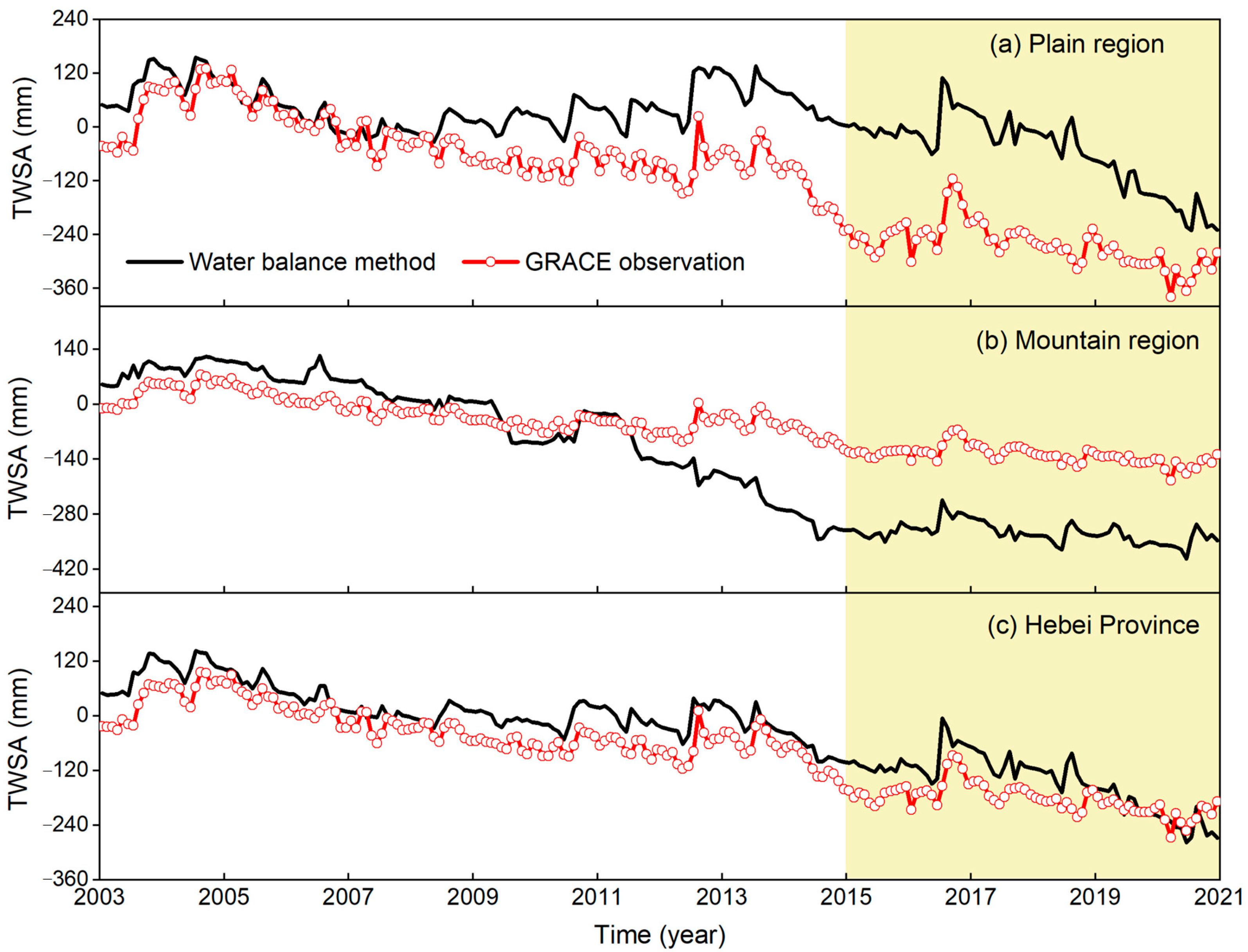
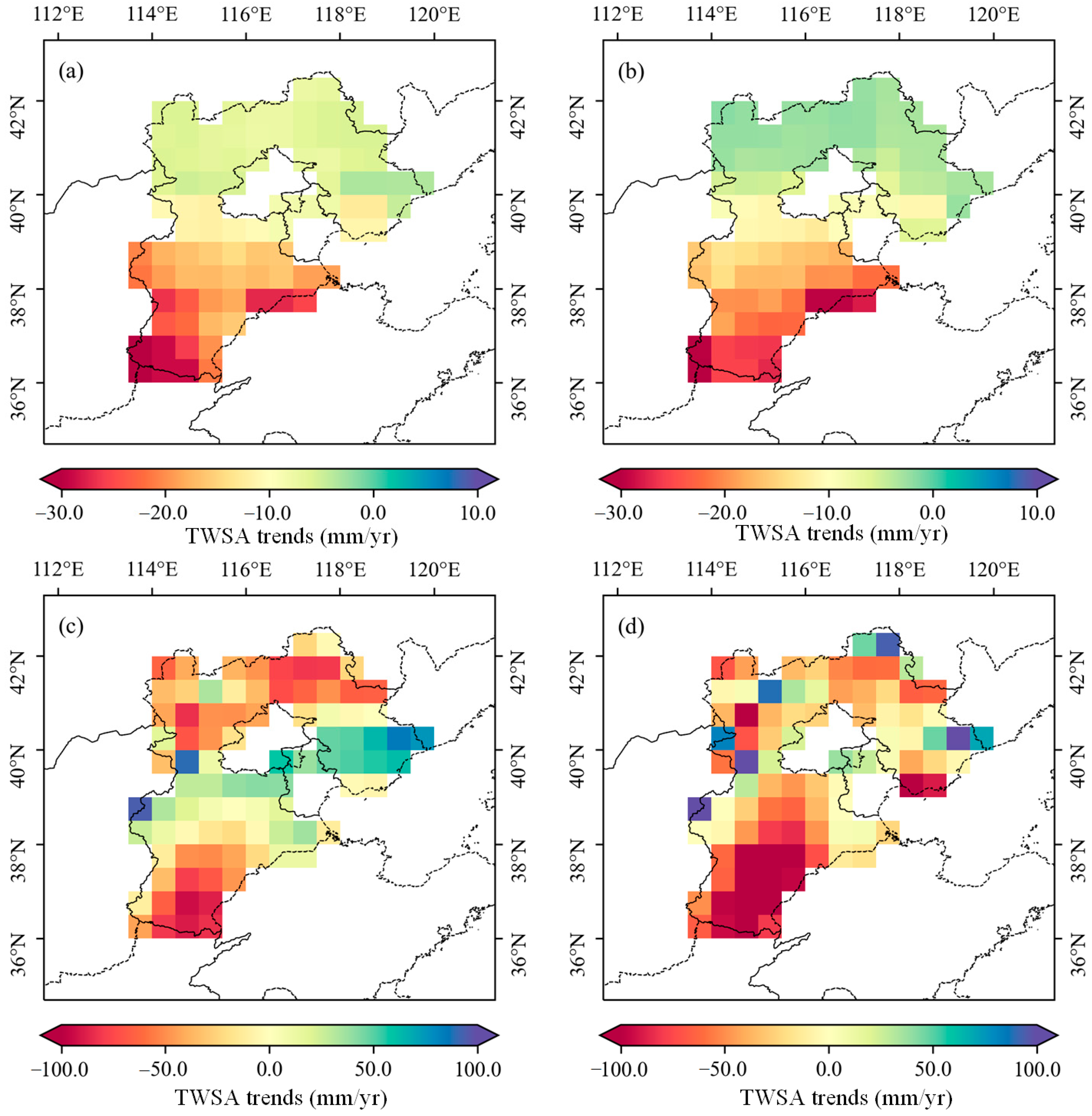
| Dataset | Sources | Spatial Resolution | Website |
|---|---|---|---|
| TWSA | CSR-M06 | 0.25° × 0.25° | http://www2.csr.utexas.edu/ |
| JPL-M06 | 0.50° × 0.50° | https://podaac-opendap.jpl.nasa.gov/ | |
| Precipitation | GPM | 0.10° × 0.10° | https://disc.gsfc.nasa.gov/ |
| CMA | 0.50° × 0.50° | http://data.cma.cn/ | |
| Noahv2.1 | 0.25° × 0.25° | https://disc.gsfc.nasa.gov/datasets | |
| ET | GLEAM | 0.25° × 0.25° | https://www.gleam.eu |
| Noahv2.1 | 0.25° × 0.25° | https://disc.gsfc.nasa.gov/datasets | |
| Runoff | Noahv2.1 | 0.25° × 0.25° | https://disc.gsfc.nasa.gov/datasets |
| Scenarios | Precipitation | ET | Runoff | Slope (mm/year) |
|---|---|---|---|---|
| Case 1 | CMA | GLEAM | Noahv2.1 | 7.93 ± 0.56 * |
| Case 2 | CMA | Noahv2.1 | Noahv2.1 | −15.66 ± 0.45 * |
| Case 3 | GPM | GLEAM | Noahv2.1 | 18.34 ± 0.78 * |
| Case 4 | GPM | Noahv2.1 | Noahv2.1 | −7.94 ± 0.50 * |
| Case 5 | Noahv2.1 | GLEAM | Noahv2.1 | 33.18 ± 0.74 * |
| Case 6 | Noahv2.1 | Noahv2.1 | Noahv2.1 | 6.86 ± 0.39 * |
| Area | Method | CC | 2003–2014 | 2015–2020 | 2003–2020 |
|---|---|---|---|---|---|
| Plain region | WB | 0.75 | −1.78 ± 1.16 ** | −38.34 ± 3.35 * | −9.53 ± 0.79 * |
| GRACE | −15.65 ± 0.99 * | −15.13 ± 2.31 * | −19.85 ± 0.57 * | ||
| Mountain region | WB | 0.91 | −34.77 ± 1.10 * | −7.03 ± 1.57 * | −31.66 ± 0.62 * |
| GRACE | −6.94 ± 0.45 * | −3.72 ± 1.45 * | −6.97 ± 0.25 * | ||
| Hebei Province | WB | 0.95 | −12.53 ± 0.77 * | −28.14 ± 2.54 * | −15.66 ± 0.45 * |
| GRACE | −12.81 ± 0.79 * | −11.41 ± 1.86 * | −16.75 ± 0.50 * |
Disclaimer/Publisher’s Note: The statements, opinions and data contained in all publications are solely those of the individual author(s) and contributor(s) and not of MDPI and/or the editor(s). MDPI and/or the editor(s) disclaim responsibility for any injury to people or property resulting from any ideas, methods, instructions or products referred to in the content. |
© 2023 by the authors. Licensee MDPI, Basel, Switzerland. This article is an open access article distributed under the terms and conditions of the Creative Commons Attribution (CC BY) license (https://creativecommons.org/licenses/by/4.0/).
Share and Cite
Liu, T.; Zhang, D.; Shi, Y.; Li, Y.; Sun, J.; Zhang, X. The Influence of the South-to-North Water-Diversion Project on Terrestrial Water-Storage Changes in Hebei Province. Water 2023, 15, 3112. https://doi.org/10.3390/w15173112
Liu T, Zhang D, Shi Y, Li Y, Sun J, Zhang X. The Influence of the South-to-North Water-Diversion Project on Terrestrial Water-Storage Changes in Hebei Province. Water. 2023; 15(17):3112. https://doi.org/10.3390/w15173112
Chicago/Turabian StyleLiu, Tianxu, Dasheng Zhang, Yanfeng Shi, Yi Li, Jianchong Sun, and Xiuping Zhang. 2023. "The Influence of the South-to-North Water-Diversion Project on Terrestrial Water-Storage Changes in Hebei Province" Water 15, no. 17: 3112. https://doi.org/10.3390/w15173112
APA StyleLiu, T., Zhang, D., Shi, Y., Li, Y., Sun, J., & Zhang, X. (2023). The Influence of the South-to-North Water-Diversion Project on Terrestrial Water-Storage Changes in Hebei Province. Water, 15(17), 3112. https://doi.org/10.3390/w15173112





